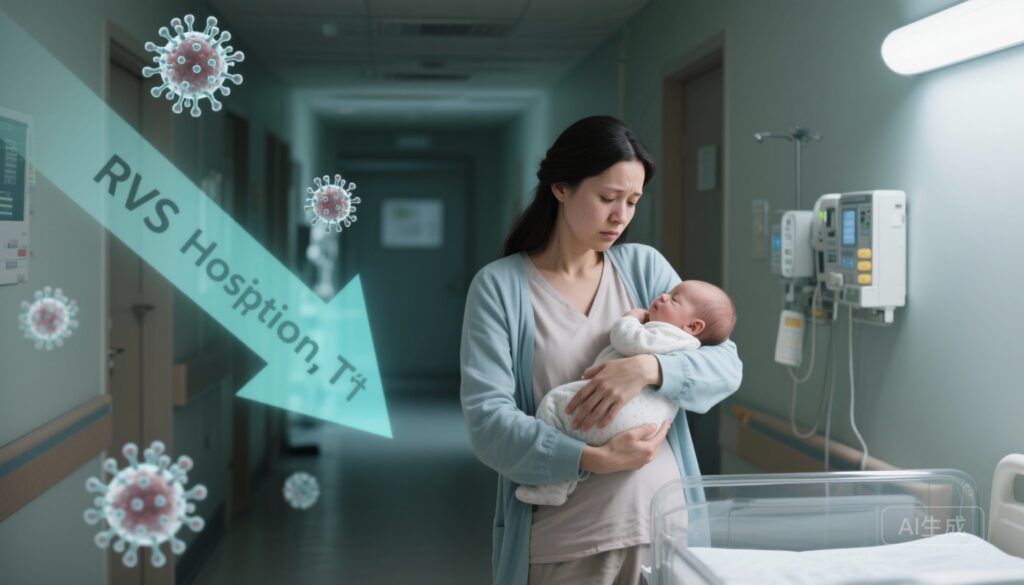Highlights
– Surveillance from the New Vaccine Surveillance Network (NVSN) documents a 39–77% relative reduction in RSV-associated hospitalizations among infants <6 months during the 2024–2025 season versus 2017–2020.
– Test-negative analyses yield real-world effectiveness estimates consistent with clinical trials: maternal RSV vaccine ~64–70% against medically attended disease and hospitalization in infants <6 months; nirsevimab ~77–81% against medically attended disease and hospitalization, and ~90% against ICU admission in infants <8 months.
– Effectiveness varied by infant age, prematurity, timing of administration, and geography, indicating opportunities to optimize delivery and equity of preventive strategies.
Background: RSV burden and the preventive gap
Respiratory syncytial virus (RSV) is a leading cause of acute lower respiratory infection and hospitalization in infants and young children worldwide. Historically, passive prophylaxis with palivizumab was reserved for small, high-risk groups (eg, very preterm infants or those with certain cardiac/ pulmonary conditions) because of cost and logistical constraints. In 2023 two new preventive options were approved and recommended for broader pediatric use: a maternal RSV vaccine designed to confer transplacental antibody protection during the first months of life and a long-acting monoclonal antibody for direct infant prophylaxis, nirsevimab. These interventions were lauded after pivotal trials showed large relative risk reductions in RSV-associated medically attended disease and hospitalization, but real-world impact needs verification as uptake, timing, and population characteristics differ from trial conditions.
Study designs and data sources
Two analyses presented at IDWeek 2025 used data from the New Vaccine Surveillance Network (NVSN), a prospective, multi-site US surveillance platform enrolling children <18 years presenting with acute respiratory illness to emergency departments, outpatient clinics, or hospitals at seven geographic sites (Rochester, Pittsburgh, Cincinnati, Nashville, Kansas City, Houston, and Seattle).
Ecological trend analysis (Schuster et al.)
Investigators compared RSV-associated hospitalization rates in infants <6 months during the full 2024–2025 RSV season to a pre-intervention baseline period (2017–2020). Cases were infants with a positive RSV PCR; analyses adjusted hospitalizations per 1,000 infants for enrollment rates, surveillance days, test sensitivity, and hospital market share to estimate relative rate reductions.
Test-negative case-control effectiveness analysis (Halasa et al.)
Using the test-negative design, investigators evaluated maternal vaccine effectiveness among infants <6 months and nirsevimab effectiveness among infants <8 months. Infants with an acute respiratory illness who tested RSV-positive were cases; those who tested negative were controls. The analysis excluded infants who received both products, those who had palivizumab, or who received nirsevimab within the previous week; and excluded infants whose mother received the maternal RSV vaccine <2 weeks before delivery. Models adjusted for site, age (in months), enrollment month, and presence of ≥1 high-risk medical condition; nirsevimab estimates additionally adjusted for insurance and prematurity status, while maternal vaccine estimates adjusted for race and ethnicity.
Key findings
Population-level reductions in hospitalization (Schuster et al.)
Across the seven NVSN sites, RSV-associated hospitalization rates in infants <6 months declined during 2024–2025 compared with 2017–2020 baseline, with relative rate reductions by site ranging from 39% to 77%.
The greatest absolute and relative declines occurred in the youngest infants. For infants aged 0–2 months, the RSV hospitalization rate fell from 29.2 per 1,000 to 12.7 per 1,000—a 56% relative reduction. For infants aged 3–5 months, rates fell from 16.3 to 11.2 per 1,000—a 31% relative reduction. Declines were consistent across all seven surveillance sites, though magnitudes varied by location.
Real-world effectiveness of maternal RSV vaccination (Halasa et al.)
The maternal vaccine analysis included 446 infants (139 RSV-positive cases [19%] and 307 RSV-negative controls [35%]). Most participants were hospitalized (61%), with 30% seen in the ED and 9% as outpatients. Adjusted effectiveness estimates were 64% against any medically attended RSV disease and 70% against RSV-associated hospitalization in infants <6 months. The investigators noted insufficient events to provide precise subgroup estimates by month of life.
Real-world effectiveness of nirsevimab (Halasa et al.)
The nirsevimab analysis comprised 1,795 infants (462 cases [14%] and 1,259 controls [44%]), with 49% hospitalized, 36% seen in ED, and 15% outpatient. Adjusted effectiveness was 76.8% against any medically attended RSV disease, 80.6% against hospitalization, and 89.6% against ICU admission.
Effectiveness was similar for RSV-A (80.2%) and RSV-B (78.8%). Nirsevimab appeared more effective in full-term infants (83.3%) than preterm infants (69.7%), and efficacy was higher when administered at birth (87.2%) than when given later in infancy (76.6%). Effectiveness was sustained through at least 5 months of age, aligning with expected duration of protection over a typical US RSV season.
Interpretation and clinical implications
These real-world NVSN data support substantial public health gains from the widespread availability of the two 2023-era RSV prevention options. The observed population-level declines in infant hospitalizations are biologically and clinically plausible given the protective effects demonstrated in trials. The test-negative estimates for maternal vaccination (~64–70% effectiveness) and nirsevimab (~77–81% against medically attended disease/hospitalization, ~90% against ICU admission) are broadly consistent with randomized controlled trial results, suggesting robust effectiveness outside trial conditions.
From a clinical and health-systems perspective, fewer infant hospitalizations and ICU admissions translate to reduced morbidity, lower resource utilization, and potential downstream economic savings. The stronger protection observed when nirsevimab is given at birth underscores the importance of timely administration for infants born during or just before RSV season. The reduced effectiveness in preterm infants suggests a need for targeted strategies—these infants remain at higher baseline risk and may derive different benefit magnitudes.
Limitations and uncertainties
Several caveats should guide interpretation. The surveillance period represents the first full season with broad availability; uptake was increasing but not universal, and availability and distribution may have varied across regions. Observational designs are susceptible to residual confounding and bias; the test-negative design mitigates some biases but cannot fully replicate randomized allocation. The maternal vaccine arm had relatively small numbers, limiting precision for subgroup analyses by infant month of life, gestational age, or maternal timing of vaccination.
Geographic heterogeneity in observed reductions suggests that access, care-seeking behavior, baseline epidemiology, and local implementation strategies shaped outcomes. Longitudinal data across additional seasons will be necessary to assess durability of population-level effects, potential shifts in RSV seasonality, and variant-specific performance. Safety surveillance must continue, especially as uptake expands.
Practice and policy considerations
Clinicians should be informed about both preventive options and counsel pregnant people and parents accordingly. For maternal vaccination, the window for transfer of protective antibodies and the timing relative to delivery are important considerations; for nirsevimab, ensuring availability at birth or early infancy appears beneficial. Systems-level interventions—prenatal care pathways for offering maternal RSV vaccination, newborn discharge planning for offering nirsevimab, and equitable access across communities—will be crucial to maximize population benefit.
Public health authorities should prioritize efforts to reduce disparities in access and uptake, collect ongoing real-world effectiveness and safety data, and refine seasonal recommendations as additional evidence accrues.
Unanswered questions and research priorities
Important gaps remain: comparative effectiveness when maternal vaccination and nirsevimab are deployed in overlapping populations; optimal timing of maternal vaccination by gestational week to maximize infant protection across months 0–6; effectiveness and safety in specific high-risk groups such as very preterm infants and those with chronic conditions; potential changes in RSV epidemiology with widespread prophylaxis; and cost-effectiveness in varied health-care settings.
Randomized or carefully controlled observational studies and robust post-marketing surveillance will be essential to refine recommendations, particularly as implementation scales up globally.
Conclusion
Early real-world data from the 2024–2025 RSV season indicate that maternal RSV vaccination and nirsevimab confer substantial protection against medically attended RSV disease and hospitalization in infants, and that their widespread availability is associated with sizable reductions in infant hospitalizations compared with pre-intervention seasons. These findings corroborate pivotal trial results and highlight the potential for meaningful public-health impact. Ongoing surveillance, attention to equitable delivery, and further research on optimal use across populations will be critical to consolidate and extend these gains.
Notable presenters quoted
Paul Spearman, MD (Cincinnati Children’s Hospital) emphasized that the studies demonstrate real-world effectiveness comparable to controlled trials and noted the potential for substantial reductions in healthcare costs. Jennifer Schuster, MD (Children’s Mercy) highlighted the dramatic reductions observed in the youngest infants. Natasha Halasa, MD (Vanderbilt University Medical Center) underscored that maternal vaccine effectiveness reflects protection during the first months and called for additional studies to evaluate month-by-month effectiveness through 6 months of age.
Funding and registration
Analyses were conducted using data from the New Vaccine Surveillance Network (NVSN). Presentations were delivered at IDWeek 2025. Specific funding statements and trial registry numbers were not detailed in the conference summaries reported here; readers should consult full meeting abstracts or subsequent peer-reviewed publications for detailed funding and registration information.



